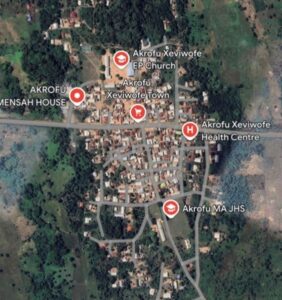 One of the ewe-speaking tribes that migrated from Notse in the 14th century under the leadership of King Blema was known as Saviawo [descendants of Sa].
One of the ewe-speaking tribes that migrated from Notse in the 14th century under the leadership of King Blema was known as Saviawo [descendants of Sa].
The exodus became necessary as a result of the tyranny of Togbe Agokoli. Notse is located in the country currently called Togo. After travelling over well as various perils the Saviawo went to a geographical location tribe known as Kpeleawo Ghana.
After the demise of their leader, King Xortor
ascended the throne. He led them from their settlement as a result of hostilities that they were subjected to by the Kpeleawo tribe. For this reason, they departed and continued on their journey in pursuit of a more fertile and hospitable environment. This phase of their migration led them to Tsevie. The leadership of the tribe fell on King Xe [the nest of an eagle cannot be easily destroyed] when it was obvious that King Xortor became too weak to discharge such responsibilities.
The name of the tribe became known as Xeviawo [the descendants of King Xe]. After his burial, King Xe continued with the migration journey through various locations such as the settlements of Matse and Ziavi. They managed to carve a place which was adjacent to these two tribes, which they named Tsyorkor.
However, they were discovered by a hunter from Ziavi called Ademega Atsokpe who invited them to Ziavi and provided them with a piece of land for their settlement within the Ziavi and Klefe tribes. The location was known as Wulate. The land belonged to King Adzanye. This area was under the jurisdiction of King Blukorli.
According to the oral narrative, King Xe possessed extraordinary spiritual powers. After a while, war broke out between Xeviawo and the Klefe tribe as a result of disagreement over the claim of ownership for the use of a stream that served the two communities.
The defeat of the Klefe tribe by King Xe led to Xeviawo becoming a taboo to date. The appellation associated with the defeat was stated as “the real sparrow, a flying bird that cannot be easily trapped”. The Klefe tribe’s response to this appellation was said to be “night falls on Xeviawo by the foot of the mountain”.
The children of King Xe were, Adzadi, Ahingble, Atefoe, and Abiwu (Abin). After the defeat of the Klefe tribe, the two sons of King Xe, Adzadi and Ahingble appealed to their aging King to permit them to move further inland in search of a more secure and fertile land that was devoid of hostilities. Granted this permission, they were able to find a peaceful vast land mainly made of volcanic rocks.
This location where they have temporarily settled was called Gbagbatoe or Kpega (big stone). In search of a river source for their survival, Adzadi was confronted with a creature that appeared like an elephant. It was a high-elevated volcanic rock.
Armed with a bow and arrow, he shot at it. Instantly he fainted. After many attempts by his brother Ahingble to locate him with a horn trumpet, he finally responded. On his return to Kpega, he narrated his encounter with the strange creature. This compelled his father King Adzadi to consult the oracles which revealed that the fetish which was left behind at Notse had followed them. That was comforting news to the elders. Subsequently, Ahingble also found a swift-flowing stream which they named Tsawe.
For that reason, Xeviawo had to relocate and resettle between river Tsawoe and the high elevated volcanic rock. This became known as the Dagbate oracle which was worshipped today. King Xe was buried at Kpega and his marked grave still exists.
After the death of King Xe, a few of his descendants moved from Gbagbatoe where they settled to a location called Gborxome. This was situated between river Tsawoe and Agorve. The Agorve clan are the descendants of the younger brother of King Xe by the name Togbe Agor. On their frequent visits to those who were left at the foot of the Dagbate rock hill, to guard the grave of King Xe, they usually indicated they were going to visit Tokor (foot of the rock hill). This was why the clan became known as Tokor royals to date.
The King who took over as leader after the death of King Xe was King Tsedatsu. Although the group split up to move northwards to settle at Saviwofe, Sovie, and Alavanyo respectively, a splinter group of the Xeviawo remained at Kpega to protect the grave of King Xe. Realizing the rapid growth in the population of the Xeviawo, coupled with the establishment of chieftaincy across the migrant ewe communities, Adzadi sacrificed his son and daughter to create a stool as they knew from Notse.
The name of Adzadi’s son who was sacrificed was Adzadi Kwadzo Bu Mensa whilst the daughter was Adzadi Yawa Kuma. The rest of Adzadi’s children were Adzadi Kwadzo Bu, Adzadi Kodzo Bu Adatsi, and Adzadi Yawa. The stool’s name was Xe-Adzadi. Since it was against the order of the oracle, Adzadi was unable to be enstooled for the first time since he established the stool. For that reason, he requested his brother Ahingble to provide a candidate for enstoolment.
Consequently, Togbe Xe-Adzadi Ahingble Komla I became the first chief of Xeviawo. After his death, Togbe Xe-Azadi Atefoe Kwami II was enstooled. When it became the turn of Adzadi after his death, Adzadi declined to provide a candidate because they held the position of fetish priest. In addition to that, there was no candidate available to offer since there were just a few.
Atefoe was therefore requested to entool again and for that reason, the son of Atefoe called Kakaklu became the next chief under the stool name Togbe Xe-Adzadi Kakaklu III. This made some of the kingmakers irate. During the yam festival festivities, an unknown person dropped fecal material in a pot of fresh palm wine. This caused Togbe Xe-Adzadi Kakaklu III so much anger and embarrassment that he abdicated the stool.
For this reason, the stool became vacant for many years without the performance of the necessary rituals. Consequently, the lives of family members were lost. Within that same period, a son of Abiwu (Abin) called Abin Kwadzo got married to the daughter of Atefoe Mansa, a sister to Atefoe Kwami (Togbe Xe-Adzadi Atefoe Kwami II). It was a family marriage. In order to resolve the lack of performance of rituals for the vacant stool, Atefoe Mansa sent the stool to her husband, Abin Kwadzo so that he could continue with the stool rituals.
According to the oral narrative, a son of Abin Kwadzo had raped the wife of Ahingble’s son. This resulted in a near-war altercation. For this obvious reason, the Abin descendants had to separate from their kinsmen and went to join a splinter group called the Wolake clan. They were accommodated by an elder of the clan called Letsu Dze.
On arrival from their farms the other members of the clan being aware of the presence of the Abin clan, made enquiries about the reason for their presence. Letsu Dze informed his kinsmen that the visitors were the Tokor (Xeviawo) clan members who came to dwell among them. They therefore became known as Tokor Vemeawo (Tokor is with them) till recent times.
Since Atefoe Mansa took the Xe-Adzadi stool along to Wolake, Abin Kwadzo installed his son Abin Foli on the stool after many years of dormancy. He was the grandson of Adzadi, Ahingble, and Atefoe under the stool name Togbe Abin Foli I. The stool name was therefore changed to Foli.
After the death of Abin Foli I, Togbe Kwadzo Foli II was installed. He however disappeared and a search for him did not yield any result today. The next chief that was enstooled was called Togbe Dugba Foli III (Agordzotor). He was killed during the Ashanti War at a location called Agorkple-eve in 1869. This became a taboo for the Tokor (Xeviwofe) clan to date.
It was rather a strange occurrence that a servant slave who was serving a traditional punishment in the house of Dake-Wude was installed after the death of Agordzotor. The name was Togbe Kataboe Foli IV.
According to the oral narrative, Togbe Kataboe Foli IV was taunted by his master to come down from the palanquin so that they would go and perform his duties on the farm. This was during the outdooring ceremony with pomp and pageantry.
This embarrassed and angered the chief to the extent that he instantly abdicated. For this reason, the stool was handed over to Dake-Wude. Subsequently, Togbe Hlodze Kwami Foli V was installed. His mother was a descendant of Tokor-Veme of the Wolake clan.
It was at this stage of history that the descendants of Adzadi, Ahingble, and Atefoe took the necessary action to retrieve the Xe-Adzadi stool. For the very reason that the stool had fallen into the hands of slaves and servants, a sacrilege. It was stated that Togbe Hlodze Kwami Foli V confirmed that indeed the stool belongs to Adzadi, Ahingble, and Atefoe.
He further indicated that he was on the stool as a nephew because his mother was the royal and not his father. He further accepted the fact that he owed his enstoolment to the Tokor clan. For this reason, he used a ram to pacify the original owners of the stool. Although the descendants of Adzadi, Ahingble, and Atefoe initially hesitated, they finally calmed down and accepted the offer with a sense of maturity.
After the death of Togbe Hlodze Kwami Foli V, Adzadi, Ahingble, and Atefoe clan demanded the return of the stool but the Wolake clan resisted the request and rather quickly installed Togbe Kwasi Foli VI. With the persistent resistance by the Wolake clan to return the Xe-Adzadi stool, the royal family of Tokor consisting of the lineage of Adzadi, Ahingble, and Atefoe, led by Afetor Gabrel Aku, initiated a very strong attempt to retrieve the Xe-Adzadi stool.
However, as consistent with the previous attempts, the Wolake clan again resisted handing over the stool. That was after the death of Togbe Kwasi Foli VI. Subsequently, the Wolake clan attempted to install Gbor Kwadzo, whose mother was a citizen of Peki Dzogbati. Unlike on the previous occasions, the kingmakers of the Tokor and Gbornyigbe clans abandoned the coronation process.
Following a misunderstanding between Gbor Kodzo and the Wolake clan, on the basis that the stool did not belong to them, and demanded it must be returned to the Tokor clan. For this reason, Togbe Kwadzo Foli VII had to abdicate. The father of Gbor Kwadzo was Tsyewogbe of Tokor-Veme from Wolake.
Before the next chief by the name Togbe Kwami Foli VIII was installed, there was an established understanding that the Xe-Adzadi stool would be handed over to the original owners. It is worth noting that the Xeviawo moved from their settlement at Gborxome to the current place called Akrofu Xeviwofe in 1900.
At that moment in history, there was a scramble over the land by the Germans and the British. The move from Gborxome by Xeviawo was compelled by the desire of the Xeviawo to remain on the British-controlled territory which was beyond the Tsawoe River. For their secure settlement, they were offered a land called Kpalita Kpogbe by Agbi Kwasi. His descendants are the Buo and Alorsor families.
Akrofu was a name coined by Akan traders who came to buy woven cloth and rubber from Xeviawo. The traders indicated that the Xeviawo village was a replica of their akan village called Nkrofu (Nkrofu-fufro – New Nkrofu). This name was eventually adulterated to be called Akrofu to date.
Scripted by: Daniel Kofi Adusu (Akrofu Xeviwofe)


























